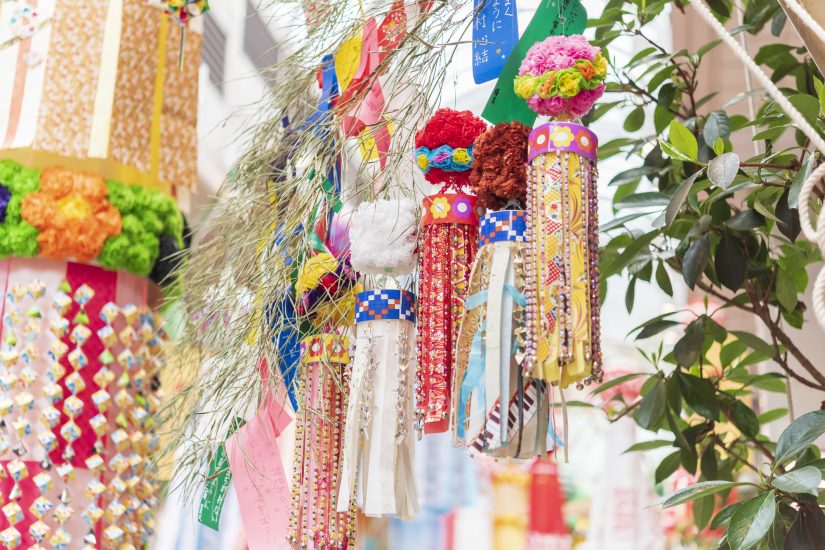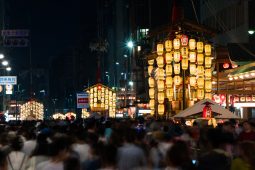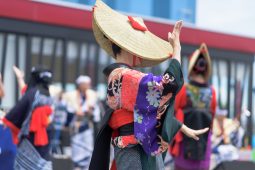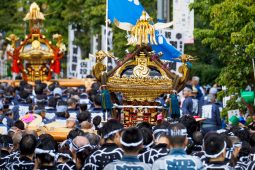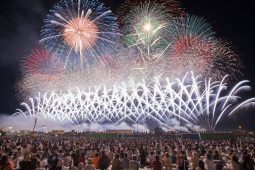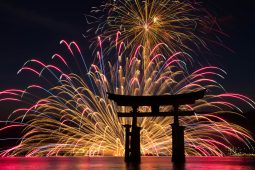This is the 2nd part of our two-part introduction to Japan’s most famous summer festivals. In Part 1 we looked at the best festivals held in July. Below is the run-down for the August matsuri season.
6. Aomori Nebuta, Aomori – August 2nd – 7th
Aomori Nebuta is one of the three biggest festivals in Japan’s northern Tohoku region. From August 2nd to the 6th there are evening parades of giant illuminated lantern floats through the streets of Aomori City. The colorful floats are made of a wire frame and washi paper covering, and decorated with images from myth, history, and kabuki drama. Between these massive floats are troupes of costumed dancers called haneto who perform an energetic jumping dance to the music of taiko drums, flutes and bells. On the 7th there is a daytime parade and a fireworks display to finish the festivities.
7.Akita Kanto, Akita – August 3rd – 6th
Akita Kanto is the second of Tohoku’s three great festivals and has been designated an Important Intangible Folk Cultural Property. During the festival two hundred poles bedecked with lanterns are paraded through Akita City to the music of flutes and taiko drums. The smallest poles have 24 lanterns and weigh between 5 and 15 kilograms, while bigger poles have 46 lanterns and weigh between 30 and 50 kilograms. Each lantern is lit with a candle and the lanterns are arranged on each pole so that it resembles an ear of rice. The chief entertainment at this event is watching the pole bearers who each carry their own pole. With great dexterity and strength they somehow manage to balance the poles on different parts of their bodies such as their palms, foreheads, hips, and shoulders. The lights of the lanterns, the passionate music, and the skill of the pole bearers all make for a truly enchanting experience.
8. Sendai Tanabata Matsuri, Miyagi – August 6th – 8th
Tanabata, also known as the “star festival,” is held all over Japan at different times, but Sendai’s Tanabata festival is the most famous and is listed as the 3rd of Tohoku’s three great festivals. The chief attraction of this festival is its decorations. Thousands of brightly colored paper streamers, 3 – 5 meters long, are used to decorate Sendai’s shopping streets. The streamers symbolize a desire for improved weaving skills, but there are other handcrafted paper decorations, each of which represents a different wish. Paper strips called tanzaku are used to carry individual wishes, paper kimono represent sewing skills, cranes represent long life and good health, purses symbolize good business, fishing nets represent good fortune, and waste baskets stand for cleanliness. Throughout the festival a variety of musical performances and folk dances take place at different venues and a fireworks display is held by the Hirose River on August 5th.
9. Hanagasa Matsuri, Yamagata – August 5th – 7th
Hanagasa Matsuri is a giant parade of 10,000 costumed dancers in 120 groups who move through the streets of Yamagata City to accompanying folk music and traditional shouts of “Yassho! Makasho!” Throughout the parade there are different styles of dance, which include traditional dances for males and females, as well as more modern creative dances. The dancers carry special hats called hanagasa (literally “flower hats”) which are decorated with red safflowers, and which they twirl in their hands as part of the dance choreography. At the end of the parade is a “walk-in” section which spectators are welcome to join in.
10. Yoshida-no-Hi Matsuri, Yamanashi – August 26th, 27th
Yoshida-no-Hi Matsuri is a fire festival centered on two shrines in Fujiyoshida City: Kitaguchi Hongu Fuji Sengen Shrine and Suwa Shrine. These shrines are located at the base of Mount Fuji and the festival is held to placate the spirit of the mountain. On the 26th there is a parade of two portable shrines around the neighborhood to a place where they will rest for the night. After this, over 70 torches are lit on the city’s main street. Each torch is over 3 meters high so this presents quite a spectacle. People also light household torches, so the whole street looks like a river of fire. On the 27th the portable shrines are once again paraded round the neighborhood before returning to Kitaguchi Hongu Fuji Sengen Shrine.


